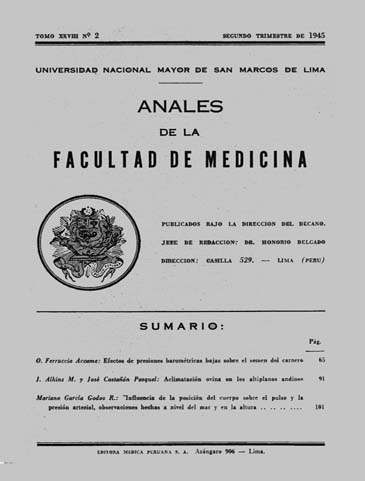Influence of body position on the pulse and blood pressure, observations at sea level and at altitude
DOI:
https://doi.org/10.15381/anales.v28i2.9645Abstract
This paper, through the study of blood pressure and heart rate in relation to postural changes, has a dual purpose: First, make a comparative study of the responses of residents sea level and the height, to thereby reach a deeper understanding of the mechanisms of circulatory adaptation of subjects living at high altitudes knowledge. Second, recent works by American authors emphasize the interest of the study of these responses in the selection of pilots, as postural changes so frequent in this profession can be taken as one of the indices (among many others) their ability to neurocirculatory adaptation more difficult to perform when the subject comes to heights. This is of particular interest when it comes to military pilots, for technical reasons, often have to perform sudden changes in position. In these cases if the neuro-circulatory response is not adequate, that is, if the vascular tone responds not properly adapting to changes occurring, the gravity acting on the blood may produce conditions plethora in the lower regions of the body, and worse yet cerebral anemia, which can be fatal in some cases. This is what is known in aviation medicine under the name of "black out" and is suffered by the pilots during the so-called dive bombing. Straightening the plane after a tailspin, the force of gravity exerted on the man and the plane is 6 or 7 times. When this force is made in man's head to the feet, blood travels to the legs and abdomen. Blood is evicted from the upper and lower zones, causing ischemia of the brain, which produces characteristic symptoms: heavy legs, amaurosis, and fainting.Downloads
Published
1945-06-18
Issue
Section
Trabajos originales
License
Copyright (c) 1945 Mariano García Godos R.

This work is licensed under a Creative Commons Attribution-NonCommercial-ShareAlike 4.0 International License.
Those authors who have publications with this magazine accept the following terms:
- Authors will retain their copyrights and guarantee the journal the right of first publication of their work, which will be simultaneously subject to Creative Commons Attribution License that allows third parties to share the work as long as its author and its first publication this magazine are indicated.
- Authors may adopt other non-exclusive licensing agreements for the distribution of the version of the published work (eg, deposit it in an institutional electronic file or publish it in a monographic volume) provided that the initial publication in this magazine is indicated.
- Authors are allowed and recommended to disseminate their work over the Internet (eg: in institutional telematic archives or on their website) before and during the submission process, which It can produce interesting exchanges and increase quotes from the published work. (See El efecto del acceso abierto ).
How to Cite
1.
García Godos R. M. Influence of body position on the pulse and blood pressure, observations at sea level and at altitude. An Fac med [Internet]. 1945 Jun. 18 [cited 2024 Aug. 17];28(2):101-23. Available from: https://revistasinvestigacion.unmsm.edu.pe/index.php/anales/article/view/9645















